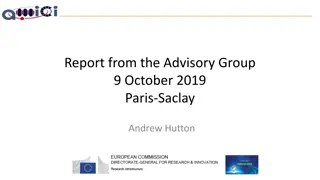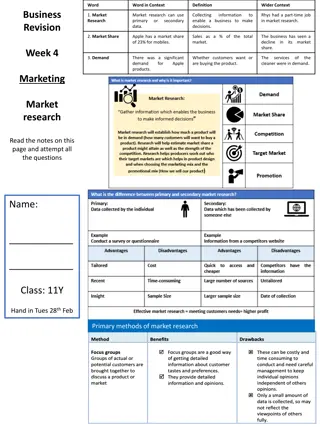Overview of Uncleared Bilateral Repo Market - Financial Research Advisory Committee Report
In April 2022, the Financial Research Advisory Committee discussed the uncleared bilateral repo market, highlighting its size, scope, lack of central counterparty, and riskier collateral. The market's segments, participants, and data collection challenges were also addressed, emphasizing the need for improved visibility and data collection practices in this significant financial sector.
Download Presentation

Please find below an Image/Link to download the presentation.
The content on the website is provided AS IS for your information and personal use only. It may not be sold, licensed, or shared on other websites without obtaining consent from the author.If you encounter any issues during the download, it is possible that the publisher has removed the file from their server.
You are allowed to download the files provided on this website for personal or commercial use, subject to the condition that they are used lawfully. All files are the property of their respective owners.
The content on the website is provided AS IS for your information and personal use only. It may not be sold, licensed, or shared on other websites without obtaining consent from the author.
E N D
Presentation Transcript
OFR Uncleared Bilateral Repo Data Collection Pilot Financial Research Advisory Committee, April 2022
Discussion Overview Part 1: What is known about the uncleared bilateral repo market? Part 2: How would a data collection help the FSOC and others? Part 3: Outstanding questions 2
Part 1: What is known about the uncleared market? Size and scope: Over $2 trillion in outstanding agreements from primary dealers alone (based on the Federal Reserve Bank of New York s Primary Dealer Statistics). A key source of hedge fund leverage (see Financial Stability Oversight Council Statement on Nonbank Financial Intermediation released February 4, 2022). Has no central counterparty or custodian (see Kahn and Olson, 2021). Likely contains riskier collateral than other segments of the repo markets (see Slide 5). 3
Part 1: What is known about the uncleared market? U.S. Repo Markets Four Segments* Tri-Party Bilateral FICC GCF Repo Service $88 billion daily in 2021 FICC serves as CCP (novates trades) BONY serves as custodian bank General collateral (generic CUSIPs) Interdealer between FICC members Treasuries, Agency debt, Agency MBS Data collected from 1 entity (FICC) FICC DVP Repo Service $907 billion daily in 2021 FICC serves as CCP (novates trades) Specific collateral (particular CUSIP) Interdealer + sponsored members Treasuries, Agency debt Data collected from 1 entity (FICC) Cleared BNY Mellon Triparty $1,813 billion daily in 2021 BONY serves as custodian bank General collateral (generic CUSIPs) Wide range of participants (just need to sign agreement with BONY) Wide range of collateral Data collected from 1 entity (BONY) Uncleared Bilateral ??? billion daily No CCP or central custodian Allows specific collateral Wide range of participants? Wide range of collateral? Little visibility; data must be collected from individual market participants Uncleared * This figure omits FICC s CCIT Service and Sponsored GC Service. For more details, see OFR Brief 21-01, Who Participates in Cleared Repo? by R. Jay Kahn & Luke M. Olson; see also the OFR s Short-term Funding Monitor. 4
Part 1: What is known about the uncleared market? Size Estimates Based on Primary Dealer Statistics for January 5, 2022: Uncleared bilateral repo was 38% of total ($947B). Uncleared bilateral reverse-repo was 62% of total ($1,205B). Uncleared Bilateral Share of Total Primary Dealer Repo by Collateral Repo Reverse repo TIPS Treasuries excluding TIPS Agency excluding MBS Agency CMBS Agency RMBS For hedge funds this market is especially important: DVP only made up $45 billion (4%) of hedge fund repo borrowing in Q1 2021. The remainder is likely mostly uncleared bilateral. (see left figure) ABS Corporate Debt Other 0.00% 20.00% 40.00% 60.00% 80.00% 100.00% Sources: Federal Reserve Bank of New York Primary Dealer Statistics, Office of Financial Research Primary Dealer Reverse-Repo Outstanding by Market ($ billions) Line series 4 Hedge Fund Repo Borrowing FICC-cleared reverse-repo All other reverse-repo 2,500 1,800 Cleared tri-party 2,000 1,500 1,500 1,200 Uncleared bilateral 900 1,000 600 500 Cleared bilateral 300 0 Dec 2019 Mar 2020 Jun 2020 Sep 2020 Dec 2020 Mar 2021 Jun 2021 Sep 2021 0 2019 Dec 2020 Mar 2020 Jun 2020 Sep 2020 Dec 2021 Mar Uncleared bilateral reverse repo is calculated as a residual using aggregates from the Primary Dealers Statistics less GCF and DVP reverse repo by primary dealers. Sources: Federal Reserve Bank of New York Primary Dealer Statistics, OFR Cleared Repo Collection, Office of Financial Research Note: FICC-cleared repo is total outstanding DVP repo for qualifying hedge funds. Sources: Securities and Exchange Commission Private Fund Statistics, OFR Cleared Repo Collection 5
Part 2: Benefits of a data collection Calls for increased transparency by regulators. Calls for more transparency from the FSOC, IAWG on Treasury markets, and senior members of the Federal Reserve Bank of New York and Treasury Department. Calls for increased transparency by the private sector. This need was highlighted in the private sector's comments on our 2018 proposed rule on cleared repo, for example: [W]e recommend that the Office proceed with collecting data on uncleared bilateral repos as well, as access to comprehensive data covering the entire repo market is critical to monitoring overall market stability. Citadel, Sept. 10, 2018 greater transparency into the repo market should help eliminate "blind spots" and facilitate the Council's risk efforts to identify and respond to emerging threats to the stability of U.S. financial markets. - Fixed Income Clearing Corporation, Sept. 10, 2018 OFR s research shows this blind-spot has only become more acute with the 2019 repo spike and March 2020 illiquidity. 6
Part 3: Outstanding questions To inform a data collection, the OFR is interested in more information on: Setting thresholds for covered reporters Existing data standards for uncleared bilateral repo transactions Life-cycle and mechanics of uncleared bilateral trades. Margining practices and collateral valuation. 7
Part 3: Outstanding questions Outreach 1. Inform in-government stakeholders of the pilot collection. 2. Consult with industry associations, financial institutions, and others. 3. Discussions with market participants. 8























